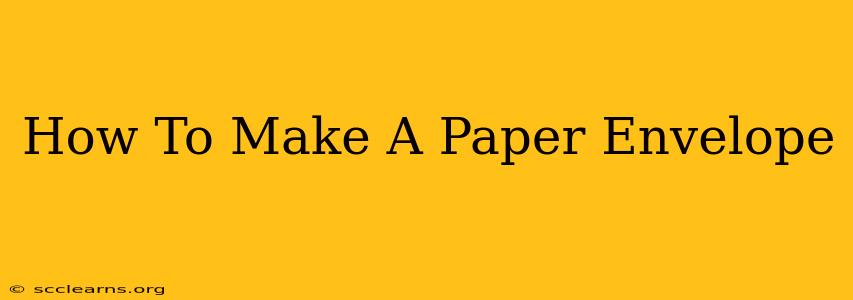Want to add a personal touch to your correspondence or create unique gift packaging? Learn how to make a simple yet elegant paper envelope right from the comfort of your home! This guide provides easy-to-follow instructions for crafting your own envelopes using readily available materials. No special tools are needed, making this a perfect DIY project for everyone, from beginners to seasoned crafters.
Materials You'll Need:
- Paper: Choose your favorite paper! Construction paper, cardstock, scrapbooking paper, or even decorative wrapping paper will work beautifully. The thickness will affect the sturdiness of your finished envelope.
- Ruler: For accurate measurements and clean lines.
- Pencil: To lightly mark your cutting and folding lines.
- Scissors or Paper Cutter: For precise cutting.
- Glue Stick or Double-Sided Tape: To securely seal your envelope. (Optional: You can also use tape).
Step-by-Step Instructions:
1. Preparing Your Paper:
Determine the desired size of your envelope. For a standard-sized envelope, start with a rectangular piece of paper. The size will depend on what you plan to put inside. Consider adding extra space for ease of insertion and closure.
2. Creating the Envelope Flaps:
- Fold the Top: Fold the top edge of your paper down to meet the bottom edge, creating a crease in the center. Open the paper back up.
- Fold the Sides: Fold the left and right edges of the paper inwards, aligning the edges with the center crease you just made. Crease well.
- Fold the Bottom Flap: Fold the bottom edge of the paper upwards, towards the top of the paper. This will form the bottom flap of your envelope. Crease sharply.
3. Shaping the Envelope:
- Forming the Sides: Carefully tuck the side flaps inwards, sliding them under the top flap. This will create the sides of your envelope. Ensure they are neatly aligned.
- Securing the Envelope: Apply glue or double-sided tape along the edges of the side flaps to securely close them. Press firmly to ensure they adhere properly.
4. Adding a Personal Touch:
Once the glue is dry, you can personalize your envelope further! Here are a few ideas:
- Decorate with Stickers or Washi Tape: Add decorative elements to complement the paper you chose.
- Draw or Paint Designs: Let your creativity flow! Add personalized drawings or paintings to make your envelopes truly unique.
- Use Embellishments: Incorporate small embellishments like beads, ribbons, or dried flowers to give your envelope an extra special touch.
Tips for Success:
- Use a Sharp Blade: Sharp scissors or a paper cutter will result in clean cuts and a neater finished envelope.
- Crease Well: Ensure you crease all folds firmly to give your envelope a crisp, professional look.
- Experiment with Different Papers: Try different paper types and weights to discover your favorites.
- Practice Makes Perfect: Don't be discouraged if your first attempt isn't perfect! The more you practice, the better you'll become at creating beautiful homemade envelopes.
Beyond the Basics:
Once you’ve mastered the basic envelope, you can explore more advanced techniques, such as creating different shapes or adding decorative closures. There are many tutorials online for more complex envelope designs to further expand your crafting skills!
Making your own paper envelopes is a fun, rewarding, and eco-friendly alternative to store-bought options. So, grab your paper and get crafting! You'll be surprised at how easy it is to create personalized and beautiful envelopes for all your needs.

